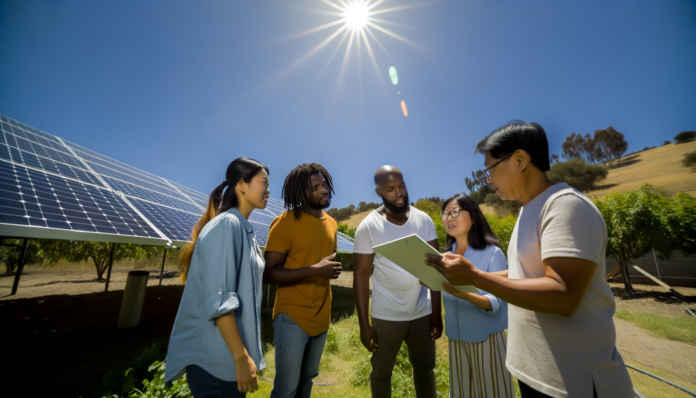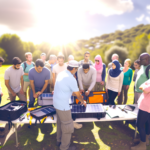Introduction to Community Solar Projects
What is Community Solar?
Community solar, also known as “shared solar,” is an innovative approach to harnessing solar energy that allows multiple participants to benefit from a single solar array. Unlike traditional solar installations that require panels to be mounted on individual rooftops, community solar projects are typically located in a central area within the community, such as a field, building, or parking lot. Participants in a community solar project subscribe to a portion of the energy produced by the solar array, receiving credits on their electricity bills for their share of the generated power. This model makes solar energy accessible to a broader audience, including renters, condo and apartment dwellers, and homeowners who cannot or prefer not to install solar panels on their own roofs.
Benefits of Community Solar
Community solar projects offer a multitude of benefits, making them an attractive option for many:
- Cost Savings: Participants often pay less for their electricity compared to traditional utility rates, leading to significant savings on energy bills.
- Environmental Impact: By supporting solar energy, participants contribute to reducing carbon emissions and promoting a cleaner, more sustainable environment.
- Accessibility: Community solar opens the door to solar energy for those who cannot install panels on their own property, including renters and those with shaded or unsuitable roofs.
- Flexibility: Many community solar programs offer no upfront costs and flexible subscription terms, making it easier for individuals to join and benefit from solar energy.
- Local Economic Benefits: These projects can create local jobs and stimulate economic growth within the community.
Why Join a Community Solar Project?
Joining a community solar project is a compelling choice for several reasons:
- Financial Savings: By subscribing to a community solar project, you can lower your monthly electricity bills through solar credits, often at a rate lower than your current utility costs.
- Environmental Stewardship: Participating in community solar allows you to play a part in the transition to renewable energy, reducing your carbon footprint and supporting a sustainable future.
- Ease of Participation: The process to join a community solar project is straightforward. You can find available projects by entering your zip code, and the subscription process typically requires minimal information, such as your email, address, utility account number, and average monthly electric bill.
- Community Engagement: Being part of a community solar project fosters a sense of community and shared purpose, as you join others in your area in supporting renewable energy initiatives.
In summary, community solar projects provide an accessible, cost-effective, and environmentally friendly way for individuals to benefit from solar energy without the need for personal solar installations. By joining a community solar project, you can enjoy financial savings, contribute to a cleaner environment, and support local economic growth, all while participating in a collective effort to promote renewable energy.
Understanding How Community Solar Works
The Basics of Solar Energy
Solar energy harnesses the power of the sun to generate electricity. Solar panels, typically made of photovoltaic (PV) cells, convert sunlight directly into electricity. This clean, renewable energy source reduces reliance on fossil fuels and decreases greenhouse gas emissions. Solar energy systems can be installed on rooftops, in open fields, or integrated into building materials. The electricity generated can be used immediately, stored in batteries, or fed into the power grid.
How Community Solar Projects are Structured
Community solar projects are designed to allow multiple participants to benefit from a single solar array. These projects are typically developed by solar companies, utilities, or community organizations. Here’s a basic structure of how they work:
1. **Development**: A solar developer identifies a suitable location for the solar array, such as a field, rooftop, or parking lot. They then design, finance, and construct the solar installation.
2. **Subscription**: Individuals, businesses, or organizations can subscribe to a share of the solar project. The size of the share often correlates with their electricity usage.
3. **Energy Production**: The solar array generates electricity, which is fed into the local power grid.
4. **Billing and Credits**: Subscribers receive credits on their electricity bills based on the amount of electricity generated by their share of the solar project. These credits reduce their overall electricity costs.
Types of Community Solar Models
Community solar projects can be structured in various ways to meet the needs of different communities and participants. Here are some common models:
1. **Ownership Model**: In this model, participants purchase a portion of the solar array. They own the panels and receive the benefits of the electricity generated, including tax incentives and credits on their utility bills. This model requires a higher upfront investment but offers long-term financial benefits.
2. **Subscription Model**: Participants subscribe to a share of the solar project and pay a monthly fee. They receive credits on their electricity bills based on the amount of electricity their share generates. This model is more accessible as it typically requires no upfront investment and offers immediate savings on electricity bills.
3. **Utility-Sponsored Model**: Some utilities develop and manage community solar projects. Customers can subscribe to these projects through their utility company. This model often simplifies the process for participants, as the utility handles all aspects of the project, including billing and maintenance.
4. **Non-Profit Model**: Community organizations or non-profits develop and manage solar projects to benefit specific groups, such as low-income households or local charities. Participants may receive reduced-cost or free electricity, and the project may be funded through grants, donations, or government incentives.
By understanding these basic principles and structures, you can better appreciate how community solar projects work and how they can benefit you and your community.
Steps to Participate in a Community Solar Project
Researching Available Projects
The first step in participating in a community solar project is to research the available options in your area. Community solar programs are expanding rapidly across the country, but availability can vary significantly by location. Start by checking if your state or utility offers community solar programs. Currently, 18 states and the District of Columbia have community solar initiatives, and many rural electric cooperatives and municipal utilities also offer these programs.
To find a community solar project near you, utilize online platforms that compare different projects. These platforms often provide detailed information about the size, location, and expected benefits of each project. Additionally, local environmental organizations and utility companies can be valuable resources for finding available projects.
Evaluating Project Terms and Conditions
Once you have identified potential community solar projects, the next step is to evaluate their terms and conditions. Not all community solar projects are created equal, so it’s crucial to understand what you are signing up for. Here are some key factors to consider:
- Cost and Savings: Ensure that the project offers a good economic deal. You should be able to lower your electric bills or receive a good return on investment. Look for projects that offer bill credits at a discounted rate compared to your current utility costs.
- Flexibility: The program should make it easy for you to subscribe and unsubscribe. Check if you can transfer your share if you move within the utility’s service territory.
- Transparency: Make sure you understand what you are paying for. The program should inform you of any ongoing charges and provide clear information about how your bill credits are calculated.
- Community Benefits: Real community solar projects provide additional benefits such as job creation, added grid resilience, and opportunities for low-income families to benefit from solar energy.
Signing Up and Getting Started
After selecting a community solar project that meets your needs, the final step is to sign up and get started. The sign-up process is usually straightforward and can often be completed online. Here’s what you can expect:
- Subscription: You will subscribe to a portion of the community solar project based on your historic energy usage. This determines the size of your share and the amount of bill credits you will receive.
- Billing: Each month, you will receive bill credits from your utility representing the amount of solar energy produced by your share of the project. These credits will offset your electric supply and delivery charges. You will then pay for the bill credits you received, but at a discounted rate.
- Activation: It typically takes about two months for the credits to start appearing on your utility bill after you subscribe to a live community solar project.
- Flexibility: If you need to leave the project, most programs allow you to do so without any fees, provided you give a notice period (usually 60 days).
By following these steps, you can confidently join a community solar project and start enjoying the economic and environmental benefits of solar energy without the need to install panels on your property.
Maximizing Your Benefits from Community Solar
Understanding Your Solar Credits
One of the primary benefits of participating in a community solar project is the ability to earn solar credits. These credits are essentially a form of compensation for the electricity generated by your share of the community solar array. Here’s how it works:
- Electricity Generation: The community solar project generates electricity, which is fed into the local power grid.
- Credit Allocation: Based on your subscription or ownership share, you receive credits on your utility bill for the electricity produced by the solar panels.
- Bill Reduction: These credits reduce the amount you owe on your electricity bill, effectively lowering your energy costs.
Understanding how these credits are calculated and applied can help you maximize your savings. Typically, the value of the credits is tied to the local utility rates, so it’s beneficial to stay informed about any changes in these rates.
Monitoring Your Solar Production
To ensure you are getting the most out of your community solar subscription, it’s important to monitor the solar production regularly. Most community solar projects provide an online dashboard or a mobile app where you can track the performance of the solar array. Here are some key metrics to keep an eye on:
- Energy Production: Check the amount of electricity generated by the solar panels over different periods (daily, monthly, annually).
- Credit Accumulation: Monitor the solar credits you are earning and how they are being applied to your utility bill.
- System Performance: Look for any discrepancies or drops in production that might indicate maintenance issues.
By staying engaged with your solar production data, you can quickly address any issues and ensure that you are maximizing your benefits.
Tips for Reducing Your Energy Consumption
While community solar can significantly reduce your electricity costs, combining it with energy-efficient practices can amplify your savings. Here are some tips to help you reduce your energy consumption:
- Upgrade to Energy-Efficient Appliances: Replace old appliances with energy-efficient models that consume less electricity.
- Use Smart Thermostats: Smart thermostats can optimize heating and cooling schedules, reducing energy waste.
- Implement LED Lighting: Switch to LED bulbs, which use less energy and have a longer lifespan compared to traditional incandescent bulbs.
- Seal and Insulate: Properly sealing and insulating your home can prevent energy loss, making heating and cooling more efficient.
- Practice Energy-Saving Habits: Simple habits like turning off lights when not in use, unplugging devices, and using natural light can make a big difference.
By integrating these energy-saving strategies with your community solar participation, you can further reduce your environmental footprint and enhance your financial savings.
Overcoming Common Challenges
Addressing Financial Concerns
Participating in a community solar project can be financially advantageous, but initial costs and ongoing expenses can be a concern for many. Here are some strategies to address these financial challenges:
- Subscription Models: Many community solar projects offer flexible subscription models that require no upfront costs. Instead, participants pay a monthly fee based on their share of the solar energy produced. This fee is often lower than traditional utility rates, leading to immediate savings on electricity bills.
- Incentives and Rebates: Look for local, state, and federal incentives that can offset costs. Programs like the Federal Investment Tax Credit (ITC) and various state-specific rebates can significantly reduce the financial burden.
- Grants and Low-Income Programs: For low-income households, there are specific grants and programs designed to make solar energy more accessible. The EPA’s Solar for All program, for example, aims to increase solar energy adoption among disadvantaged communities.
Dealing with Technical Issues
Technical challenges can arise in any solar project, but community solar projects have unique considerations. Here’s how to navigate them:
- Reliable Partners: Choose a community solar project managed by reputable companies with a proven track record. This ensures that the technical aspects, from installation to maintenance, are handled professionally.
- Maintenance and Support: One of the benefits of community solar is that maintenance is typically managed by the project operator. Ensure that the project you join offers robust support and quick resolution of any technical issues.
- Advanced Monitoring Systems: Many community solar projects use advanced monitoring systems that allow participants to track their solar production and energy savings in real-time. This transparency helps in quickly identifying and addressing any technical problems.
Navigating Regulatory Hurdles
Regulatory challenges can be a significant barrier to participating in community solar projects. Here are some ways to overcome these hurdles:
- Understanding Local Regulations: Regulations for community solar projects vary by state and locality. It’s crucial to understand the specific rules and incentives in your area. Resources like the Database of State Incentives for Renewables & Efficiency (DSIRE) can provide valuable information.
- Advocacy and Policy Support: Engage with local representatives and advocacy groups to support policies that promote community solar. Legislative changes can often remove barriers and create a more favorable environment for these projects.
- Legal Assistance: For complex regulatory issues, consider seeking legal advice. Some community solar projects offer legal support to help navigate the regulatory landscape, ensuring compliance and maximizing benefits.
By addressing these common challenges—financial concerns, technical issues, and regulatory hurdles—you can more effectively participate in and benefit from community solar projects. These solutions not only make it easier to join a project but also ensure that you can maximize the advantages of clean, renewable energy.
Community Solar Success Stories
Case Study: Rural Community Solar Project
In rural areas, community solar projects have become a beacon of hope for sustainable energy solutions. One notable example is the community solar project in a small town in Colorado. This project was initiated by a local cooperative that saw the potential of solar energy to not only reduce electricity costs but also to foster community engagement and resilience.
The cooperative worked closely with local farmers to lease land for the solar arrays, ensuring that the project had minimal environmental impact. The project was designed to be inclusive, allowing low-income families to participate at reduced rates. The benefits were manifold: local job creation, reduced energy costs for participants, and a significant reduction in the community’s carbon footprint.
The success of this rural community solar project has inspired neighboring towns to explore similar initiatives, proving that even small communities can make a big impact when they come together for a common cause.
Case Study: Urban Community Solar Initiative
Urban areas face unique challenges when it comes to implementing solar energy solutions, primarily due to space constraints and higher population density. However, the Urban Community Solar Initiative in New York City has demonstrated that these challenges can be overcome with innovative thinking and strong community support.
This initiative was spearheaded by a coalition of local non-profits, businesses, and city officials. They identified underutilized spaces such as rooftops of public buildings and parking lots to install solar panels. The project was structured to allow residents to subscribe to shares of the solar energy produced, providing them with credits on their electricity bills.
One of the standout features of this initiative is its focus on inclusivity. Special efforts were made to ensure that low-income households could participate and benefit from the savings. The project also included educational programs to raise awareness about renewable energy and its benefits. The Urban Community Solar Initiative has not only reduced energy costs for thousands of residents but has also set a precedent for other cities to follow.
Case Study: Off-Grid Community Solar Solutions
In remote areas where access to the traditional power grid is limited or non-existent, off-grid community solar solutions have emerged as a viable alternative. A remarkable example of this is the off-grid solar project in a remote village in Alaska.
The village, which previously relied on expensive and polluting diesel generators, partnered with a renewable energy company to develop a community solar project. Solar panels were installed along with battery storage systems to ensure a reliable power supply even during the long winter months when sunlight is scarce.
The project was funded through a combination of grants, community fundraising, and contributions from the renewable energy company. The benefits were immediate and profound: the village saw a drastic reduction in energy costs, improved air quality, and enhanced energy independence. The success of this off-grid community solar solution has garnered attention and support from other remote communities facing similar challenges.
These case studies highlight the versatility and potential of community solar projects to bring about positive change, regardless of the setting. Whether in rural, urban, or remote areas, community solar offers a sustainable and inclusive path to a cleaner energy future.
Future of Community Solar
Innovations in Solar Technology
The future of community solar is bright, thanks to continuous advancements in solar technology. **Bifacial solar panels**, which capture sunlight on both sides, are becoming more prevalent, increasing energy output without requiring additional space. **Solar tracking systems** that follow the sun’s path throughout the day are also gaining traction, further optimizing energy production. Additionally, **energy storage solutions** like advanced batteries are improving, allowing for the storage of excess solar energy for use during non-sunny periods. These innovations not only enhance the efficiency and reliability of community solar projects but also make them more economically viable.
Policy and Regulatory Trends
Policy and regulatory frameworks play a crucial role in the expansion of community solar. In many regions, **net metering policies** allow participants to receive credits for the excess energy their portion of the solar array generates. However, these policies are continually evolving, and staying informed about local regulations is essential. **Incentive programs** and **tax credits** at both the federal and state levels can significantly reduce the cost of participating in community solar projects. Moreover, some states are introducing **mandates** that require a certain percentage of energy to come from renewable sources, further driving the adoption of community solar.
How to Stay Involved and Informed
Staying involved and informed is key to maximizing the benefits of community solar. Here are some tips:
- Join Local Advocacy Groups: These groups often have the latest information on policy changes and new projects.
- Subscribe to Newsletters: Many organizations offer newsletters that provide updates on solar technology and policy developments.
- Attend Community Meetings: Local meetings are a great way to stay informed about new projects and to voice your support for community solar initiatives.
- Follow Industry Leaders on Social Media: Platforms like Twitter and LinkedIn are excellent for real-time updates and expert opinions.
By staying engaged, you can not only benefit from the latest advancements and policy changes but also contribute to the growth and success of community solar projects.






